the short version
Kurt Lichtmann
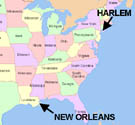 Swing
was born in the USA, in the late 1920s, following the Ragtime (WWI)
and Charleston (mid-20s) eras. The music came out of the south (New Orleans),
and the dance (Lindy Hop) debuted and developed in the north (Harlem).
American swing music and dance represent a union of two very different continental
temperaments: Europe and Africa.
Swing
was born in the USA, in the late 1920s, following the Ragtime (WWI)
and Charleston (mid-20s) eras. The music came out of the south (New Orleans),
and the dance (Lindy Hop) debuted and developed in the north (Harlem).
American swing music and dance represent a union of two very different continental
temperaments: Europe and Africa.
| EUROPE | AFRICA |
| carefully crafted composition | free-wheeling improvisation |
| conformity to the collective | quirky individuality accepted and valued |
| constrained body movement | completely free body movement |
| reserved emotional discipline | unfettered, intense, joyous expression |
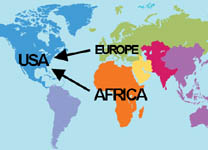
From EUROPE:
the big band instruments (trumpets, trombones, saxophones, clarinets,
drums), composition, orchestration, and scoring (writing down parts) techniques.
From AFRICA: the musical style, including the swing grooves,
rhythmic sense (and the rhythms), feel, and improvisational sense. The
Charleston dance comes from Africa.
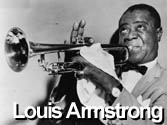 Louis
Armstrong born in a New Orleans ghetto, and defined jazz solo style
for all time. African-American band leader Don Redman, with a college
degree in music, created the big band jazz format. He got the idea when
he was still in high school at age 14.
Louis
Armstrong born in a New Orleans ghetto, and defined jazz solo style
for all time. African-American band leader Don Redman, with a college
degree in music, created the big band jazz format. He got the idea when
he was still in high school at age 14.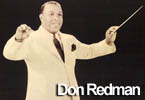 He
put the vitality of raw New Orleans jazz into an organized brass orchestra
package. Now, only one person at a time played an improvised solo, supported
by orchestrated, written down group structure. Redman also divided the
band into sections, which played off against each other.
He
put the vitality of raw New Orleans jazz into an organized brass orchestra
package. Now, only one person at a time played an improvised solo, supported
by orchestrated, written down group structure. Redman also divided the
band into sections, which played off against each other.
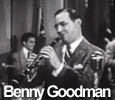 White
band leader Benny Goodman ("the king of swing") was one
of the first, and certainly the most visible, to integrate his band -
black and white musicians making music together on stage. This was a bold
social move in the 30s, when America's racial segregation and racial oppression
were comfortably accepted by white society. Musicians became unwitting
exponents of social change, refusing to stay or play at places if their
black colleagues were denied admittance. There are many stories of gross
racism against integrated bands who attempted to tour the southern USA.
White
band leader Benny Goodman ("the king of swing") was one
of the first, and certainly the most visible, to integrate his band -
black and white musicians making music together on stage. This was a bold
social move in the 30s, when America's racial segregation and racial oppression
were comfortably accepted by white society. Musicians became unwitting
exponents of social change, refusing to stay or play at places if their
black colleagues were denied admittance. There are many stories of gross
racism against integrated bands who attempted to tour the southern USA.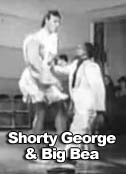 \
\
Not only
swing music, but also Swing Dance was created by African-Americans.
They applied their traditions of expression and improvisation to the European
partner dance tradition. In Africa, people did not dance as couples, nor
did they touch each other while dancing. European partner style, although
highly developed and complex, was stiff - you didn't move hips, shoulders,
or chest! The marraige of the two traditions gave birth to partnered
jazz dancing.
At first, swing dance was called Lindy Hop. Dancer Shorty George
Snowden came up with this name off-the-cuff at a dance marathon. He
was thinking of a news headline: "Lindy (Charles Lindbergh) Hops
The Atlantic," the world's 1st transatlantic flight. Although Shorty George didn't create
the dance, he helped popularize its main gesture: swinging in and out
from closed to open positions, improvising steps and movement (the swing-out).
Lindy Hop had roots in the deep south, but reached its peak sophistication
in Harlem NY. From the late 1930s on, Jitterbug, coined by flamboyant
band leader/ composer/ singer) Cab Calloway, became the media's
pet term for swing dance.
the world's 1st transatlantic flight. Although Shorty George didn't create
the dance, he helped popularize its main gesture: swinging in and out
from closed to open positions, improvising steps and movement (the swing-out).
Lindy Hop had roots in the deep south, but reached its peak sophistication
in Harlem NY. From the late 1930s on, Jitterbug, coined by flamboyant
band leader/ composer/ singer) Cab Calloway, became the media's
pet term for swing dance.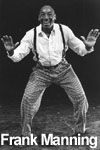 (Lindbergh's mis-guided Nazi sympathies caused everything previously named
for him to be shunned.)
(Lindbergh's mis-guided Nazi sympathies caused everything previously named
for him to be shunned.)
African-American Harlem Savoy Ballroom-based dance troupe Whitey's
Lindy Hoppers (named by their manager, ex-boxer African-American Herbert
White) defined high-energy performance style to the present day. Frank
Manning (1914-2009), key member of that group, continued to dance
and teach internationally, well into his 90s. A living icon of the swing
era, he inspired millions of dancers, including yours truly.
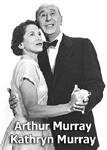 At
first, the ballroom instructors considered jitterbug wild, unteachable,
and against everything they had been trying to accomplish in the ballroom.
They preferred FOXTROT for dancing to the universally popular swing music
of the time. However, after several years of alternately denigrating and
ignoring lindy hop, Arthur Murray told his instructors to go into
the clubs in their respective cities, find out what people were doing,
and start teaching that. Eventually a standard ballroom version of swing
was created: what is now commonly called East Coast Swing, a codified
simplification of the vast possiblities of Lindy Hop. In Europe, the U.K.
teachers created Jive, their ballroom version of Lindy Hop.
At
first, the ballroom instructors considered jitterbug wild, unteachable,
and against everything they had been trying to accomplish in the ballroom.
They preferred FOXTROT for dancing to the universally popular swing music
of the time. However, after several years of alternately denigrating and
ignoring lindy hop, Arthur Murray told his instructors to go into
the clubs in their respective cities, find out what people were doing,
and start teaching that. Eventually a standard ballroom version of swing
was created: what is now commonly called East Coast Swing, a codified
simplification of the vast possiblities of Lindy Hop. In Europe, the U.K.
teachers created Jive, their ballroom version of Lindy Hop.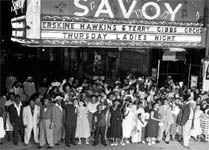
During the 1930s-40s, swing was popular throughout the USA. In Harlem
NY's Savoy Ballroom, black and white couples were dancing together.
Outside of Harlem, dance halls often used a rope to separate the races,
but at least they were in the same room! The US government promoted swing
as the symbol of multicultural America, a land where cultural unions produced
something strong and good. Nazi theorists held an opposite view, outlawing
swing, regarding cultural unions as weakening mongrelizations.
This view led them to see the American military, "mixed race,
mixed culture," as no threat to them. Although one error of judgement
among many in the Nazi leadership, this one was the cause of their downfall.
The swing feel:
you can dance appropriate fast or slow swing styles to any big band, R&B,
or country tune with a groove, but the musical swing feel is about
the peculiar emphasis in the triple division of time:
YES: 1and a 2 and a
3 and a 4 and a (1930s
- 50s swing: Dorsey, Goodman, Basie, Sinatra...)
NO:
1 and a 2 and
a 3 and a 4
and a (polka and tarantella)
NO: 1 and 2
and 3 and 4 and
(1/8
note division: pop, rock, motown, disco - Chuck Berry, Rolling Stones,
Springsteen, MJ, ...)
There is pop & rock that swings but it is
like the 1st timing adding strong 2, strong 4 such as:
Heatwave (Supremes), Part Time Lover (Stevie
Wonder, Spank Me (Madonna) ...
In the late 40s, harder
rhythms began to appear, starting with the piano-driven boogie-woogie
craze, Then came rhythm and blues ( R&B) with electric guitar
and bass, Las Vegas lounge swing, Rock & Roll, Disco, and more. New
swing dance styles emerged from the '30s onward to suit the musical styles:
West Coast Swing (state dance of California), Carolina
Shag (North Carolina's state dance), Balboa (Bal-Swing) from
Southern California, the St. Louis Imperial, Washington DC Hand
Dancing.
in the late 1990s Brian Setzer's cover of Jump Jive &
Wail (by Louis Prima) and the TV GAP commericial heralded the
swing revival. Jump bands Big Bad Voodoo Daddy (You & Me &
The Bottle) and C.P. Daddies ( Zoot Suit Riot) provided Billboard
chart hit anthems of the Neo-Swing era. A jump style of swing
emerged from Sourthern California at the same time, orginally
called Retro-swing. Ithaca put its own stamp on it, bringing in
Charleston and Lindy jazz moves, hence Ithaca Jumpswing, and it
is likely that more styles of swing will come in the future.